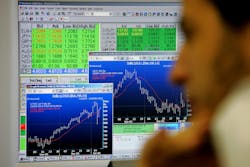Texas factory activity increased again in September, according to the Federal Reserve Bank of Dallas. The production index, a key measure of state manufacturing conditions, rose markedly from 6.8 to 17.6, indicating output grew at a faster pace than in August.
Expectations regarding future business conditions remained optimistic in September. The index of future general business activity fell from 18.7 to 12.1, while the index of future company outlook rose from 30.1 to 32.3. Indexes for future manufacturing activity generally moved down in September but remained in solidly positive territory.
Other measures of current manufacturing activity also reflected significantly stronger growth in September. The new orders index climbed 5 points to 7.5.
The capacity utilization index surged to 20.2 after dipping to 3.6 in August, with nearly a third of manufacturers noting an increase. The shipments index rebounded to 15.9 after falling to 6.4 last month.
Perceptions of broader business conditions were more optimistic this month. The general business activity index moved up to a reading of 10.8, nearly four points above its nonrecession average of 7.
The company outlook index rose from 1.5 to 5.8, due to a larger share of firms noting an improved outlook in September than in August.
Labor market indicators reflected continued employment growth and longer workweeks. The September employement index posted a fourth robust reading, holding fairly steady at 10.6. Twenty-four percent of firms reported net hiring compared with 14 percent reporting net layoffs. The hours worked index rose to a five-month high of 9.5, indicating a stronger rise in hours worked than in recent months.
Upward pressure on prices eased slightly in September, while wage pressure increased. The raw materials price index fell seven points to a reading of 19.5. The finished goods price index also fell but to a lesser degree, edging down from 9.1 to 7. The wages and benefits index, however, ticked up for the second month in a row and came in at 26.2, its highest reading since before the Texas recession began in mid-2008.
About the Author

Adrienne Selko
Senior Editor - MH&L, IW, & EHS Today
Adrienne Selko has written about many topics over the 17 years she has been with Endeavor Business Media and currently focuses on workforce development strategies. Previously Adrienne was in corporate communications at a medical manufacturing company as well as a large regional bank.
She is the author of Do I Have to Wear Garlic Around My Neck? which made the Cleveland Plain Dealer's best sellers list. She is a senior editor at Material Handling & Logistics, EHS Today, and IndustryWeek.
Editorial Mission Statement:
Manufacturing is the enviable position of creating products, processes, and policies that solve the world’s problems. When the industry stepped up to manufacture what was necessary to combat the pandemic, it revealed its true nature. My goal is to showcase the sector’s ability to address a broad range of workforce issues including technology, training, diversity & inclusion, with a goal of enticing future generations to join this amazing sector.
Why I Find Manufacturing Interesting:
On my first day working for a company that made medical equipment such as MRIs, I toured the plant floor. On every wall was a photo of a person, mostly children. I asked my supervisor why this was the case and he said that the work we do at this company has saved these people’s lives. “We never forget how important our work is and everyone’s contribution to that.” From that moment on I was hooked on manufacturing.
I have talked with many people in this field who have transformed their own career development to assist others. For example, companies are hiring those with disabilities, those previously incarcerated, and other talent pools that have been underutilized. I have talked with leaders who have brought out the best in their workforce, as well as employees doing their best work while doing good for the world.
